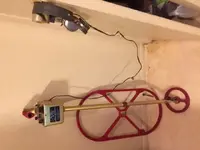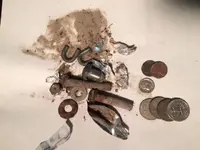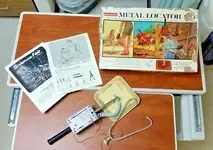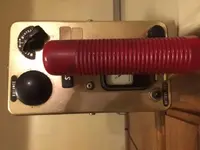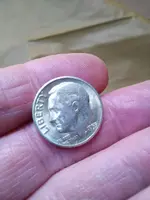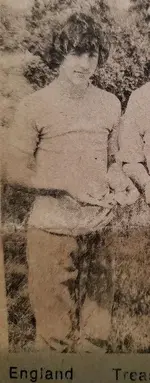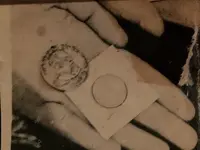- #1
Thread Owner
I was curious what detecting back in the BFO days was like. So I picked this D-TEX up dirt cheap on the bay --- it cost the poor seller more to mail it to me than he made in total. I had my doubts it would even work because that's the way it was pitched. Not to mention that it showed signs of being mishandled in it's USPS journey. The headphone plug has a plastic housing that was missing a big piece I later found in the box. And hey, the entire rig is roughly 50 years old give or take a few....
It fired right up though with a single alkaline 9V with sound coming from both ears (no speaker). As a first time BFO user the biggest adjustment I had to make was that instead of a silent threshold the goal is to turn the "Balance" knob to find a constant loud whirring. Even with the volume control/ "On" switch this gets irritating after while. The second major adjustment was although it weighs only around 3 pounds the ergonomics of swinging it really fatigues your arm. Maybe after enough use with the 7" coil I can use the 24" x 12" coil shown...? Lol
Anyway, I decided the best place to test it out was at a sandy local tot lot. Didn't want to do any heavy digging the first time. For the uninitiated the constant whirring I mentioned above changes pitch and tone when crossing over metal. The shift is very subtle which is the third major thing I had to get used to. It's more pronounced for quarters than dimes or pennies and of course on cross bars etc it's really clear and obvious. Target size and depth for smaller coins are what takes the most practice I think. Who knows, I may have missed a diamond engagement ring because I can't imagine that making much of a sound.
The pictured ad's bold claim that it detects the iron flecks in paper money seems ridiculous, but I've read posts that old timers swear it's true. I can vouch for the "No Drift" claim as I only had to adjust it a few times which was less than I expected. The coils were sold separately for this machine which got cut off in the picture. The 7" inch would've set you back $19.99 in 1970 dollars or about $120 in today's dollars. The much larger 24" x 12" coil would've cost $32 or about $192 today. The headphones another $10 or $60. And the machine itself $82.50 or just under $500. So in today's money this would've been the equivalent of close to $900.
The fourth major adjustment I had to make is that you literally are digging everything as pictured. Some advise doing the same today using even the most advanced detectors available.... Beside the junk and the $1.12, I found a new level of respect for the legendary manufacturer of this machine --- Bill Mahan and other T-Hers of the era like KVM, Garrett, "Hardrock" Hendricks, "Apache Jim" Wilson etc. etc. At one point when BFO machines were the best thing going they took rudimentary technology and turned it into some astonishing finds and made livings as professionals. Some on here have argued that BFOs are underrated even now. As for me, I've done worse than a $1.12 in more time than 2 & 1/2 hours with more advanced machines....
If any experienced D-TEX users want to weigh in on tuning this thing for maximum performance with both coils, I'm all ears....
HH
-spyguy
It fired right up though with a single alkaline 9V with sound coming from both ears (no speaker). As a first time BFO user the biggest adjustment I had to make was that instead of a silent threshold the goal is to turn the "Balance" knob to find a constant loud whirring. Even with the volume control/ "On" switch this gets irritating after while. The second major adjustment was although it weighs only around 3 pounds the ergonomics of swinging it really fatigues your arm. Maybe after enough use with the 7" coil I can use the 24" x 12" coil shown...? Lol
Anyway, I decided the best place to test it out was at a sandy local tot lot. Didn't want to do any heavy digging the first time. For the uninitiated the constant whirring I mentioned above changes pitch and tone when crossing over metal. The shift is very subtle which is the third major thing I had to get used to. It's more pronounced for quarters than dimes or pennies and of course on cross bars etc it's really clear and obvious. Target size and depth for smaller coins are what takes the most practice I think. Who knows, I may have missed a diamond engagement ring because I can't imagine that making much of a sound.
The pictured ad's bold claim that it detects the iron flecks in paper money seems ridiculous, but I've read posts that old timers swear it's true. I can vouch for the "No Drift" claim as I only had to adjust it a few times which was less than I expected. The coils were sold separately for this machine which got cut off in the picture. The 7" inch would've set you back $19.99 in 1970 dollars or about $120 in today's dollars. The much larger 24" x 12" coil would've cost $32 or about $192 today. The headphones another $10 or $60. And the machine itself $82.50 or just under $500. So in today's money this would've been the equivalent of close to $900.
The fourth major adjustment I had to make is that you literally are digging everything as pictured. Some advise doing the same today using even the most advanced detectors available.... Beside the junk and the $1.12, I found a new level of respect for the legendary manufacturer of this machine --- Bill Mahan and other T-Hers of the era like KVM, Garrett, "Hardrock" Hendricks, "Apache Jim" Wilson etc. etc. At one point when BFO machines were the best thing going they took rudimentary technology and turned it into some astonishing finds and made livings as professionals. Some on here have argued that BFOs are underrated even now. As for me, I've done worse than a $1.12 in more time than 2 & 1/2 hours with more advanced machines....
If any experienced D-TEX users want to weigh in on tuning this thing for maximum performance with both coils, I'm all ears....
HH
-spyguy



